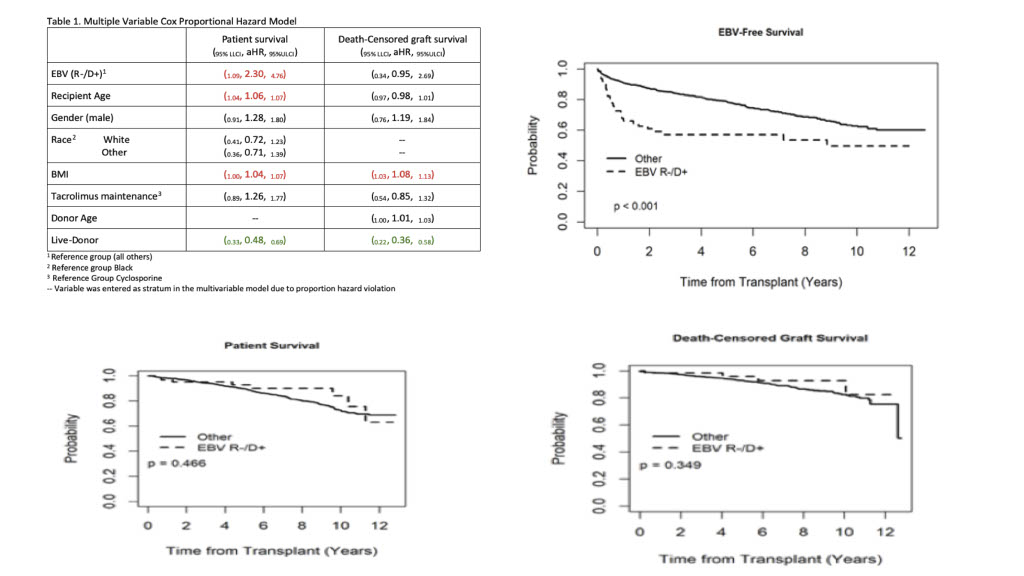Impact of High-Risk EBV Discordance Status on Survival Outcomes in Kidney Transplant Recipients: A Multivariable Analysis
A. Dinesh1, S. Jackson2, T. L. Pruett1, S. Riad3
1Division of Transplantation, Department of Surgery, University of Minnesota, Minneapolis, MN, 2Biostatistics, Analytics Consulting Services- Solid Organ Transplant, M Health Fairview, Minneapolis, MN, 3Department of Medicine, University of Minnesota, Minneapolis, MN
Meeting: 2021 American Transplant Congress
Abstract number: 165
Keywords: Epstein-Barr virus (EBV), Graft survival, Kidney transplantation, Survival
Topic: Clinical Science » Infectious Disease » Kidney Infectious Non-Polyoma & Non-Viral Hepatitis
Session Information
Session Name: Infections in Kidney Recipients
Session Type: Rapid Fire Oral Abstract
Date: Sunday, June 6, 2021
Session Time: 6:00pm-7:00pm
 Presentation Time: 6:35pm-6:40pm
Presentation Time: 6:35pm-6:40pm
Location: Virtual
*Purpose: High-risk EBV discordance has been linked to Post-Transplant Lymphoproliferative Disorder (PTLD) after kidney transplantation; however, the impact on recipient and graft survival is under-reported. We sought to examine the survival outcomes by EBV concordance status.
*Methods: We retrospectively reviewed all primary kidney transplant recipients from 2008-2019. At our institution, we use Thymoglobulin (r-ATG) induction with early steroid withdrawal followed by CNI plus MMF maintenance. We grouped the patients according to EBV status into high-risk status recipients (EBV IgG R-/D+) (n=62) and low-risk status recipients (EBV IgG R+/D+, R+/D- or R-/D-) (n=1224). Kaplan-Meier curves were generated for recipient survival, death-censored graft survival, and EBV infection-free survival. We examined the effect of EBV high-risk status on outcomes of interest in a multivariable Cox proportional hazards model adjusted for age, gender, race, BMI, maintenance immunosuppression, and donor type. EBV-free survival was not modeled due to severe proportional hazard violations.
*Results: In univariate analysis, neither patient (log-rank, p=0.466) nor death censored graft survival (log-rank, p=0.349) differed between low and high-risk groups. However, EBV-free survival was significantly lower in the high-risk group (log-rank, p<0.001). In the multivariable model, high-risk EBV status was associated with a 2.3-fold increased risk of mortality compared to low-risk status [HR 2.3, 95% C.I. (1.09, 4.76), p=0.03]. However, EBV status was not a predictor for death-censored graft survival in the adjusted model. The live-donor kidney was associated with 52% improved patient survival and 64% improved graft survival, independent of EBV status.
*Conclusions: In primary kidney transplant recipients receiving r-ATG induction immunosuppression followed by CNI plus MMF maintenance with early steroid withdrawal, the incidence of post-transplant EBV viremia is significantly higher in the (R-/D+) group. As compared to low-risk status recipients, EBV high-risk status recipients had increased mortality.
To cite this abstract in AMA style:
Dinesh A, Jackson S, Pruett TL, Riad S. Impact of High-Risk EBV Discordance Status on Survival Outcomes in Kidney Transplant Recipients: A Multivariable Analysis [abstract]. Am J Transplant. 2021; 21 (suppl 3). https://atcmeetingabstracts.com/abstract/impact-of-high-risk-ebv-discordance-status-on-survival-outcomes-in-kidney-transplant-recipients-a-multivariable-analysis/. Accessed December 15, 2025.« Back to 2021 American Transplant Congress

